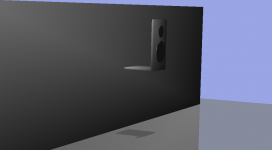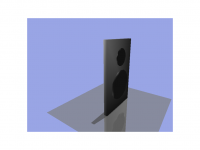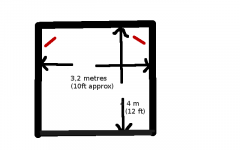I have connected my open baffle speakers to my micro amp and it all sounds OK. Whatever sound is produced is clear, there is a lack of resonance of any sort. I can hear the bass but it is not very prominent, with the speakers against the wall, this is to be expected.
I know from experiment that moving the speakers towards the wall collapse the sound and also that if the open baffle speakers are about 30 cm from the rear wall the bass effect is substatially enhanced.
I want to mount the speakers at ear level on the walls, what is the best way to do this? I was thinking of either using the bottom support or top support as shown, which will be better for sound reproduction?
I know from experiment that moving the speakers towards the wall collapse the sound and also that if the open baffle speakers are about 30 cm from the rear wall the bass effect is substatially enhanced.
I want to mount the speakers at ear level on the walls, what is the best way to do this? I was thinking of either using the bottom support or top support as shown, which will be better for sound reproduction?
Attachments
Last edited:
Another view
Created in Wings 3D and rendered in G3 Viewer.
BTW a continuation of this http://www.diyaudio.com/forums/full-range/291752-open-baffle-wall-mini-speakers.html
Created in Wings 3D and rendered in G3 Viewer.
BTW a continuation of this http://www.diyaudio.com/forums/full-range/291752-open-baffle-wall-mini-speakers.html
Attachments
Last edited:
You're probably better off at this point mounting your drivers in wall for IB instead of OB. If you can?, make an opening in the wall cavity where you want the speakers to be, and simply gasket and mount the OB baffle over it etc..
Thanks but in wall will not be possible in this case. I am looking at some bracket designs for mounting the speaker, but should I angle the OB speaker - it seems it will lose the effect of the rear wall if angled.
Update: http://www.diyaudio.com/forums/full-range/211319-open-baffle-placement-near-walls.html
Update: http://www.diyaudio.com/forums/full-range/211319-open-baffle-placement-near-walls.html
Last edited:
What about hanging them from the ceiling from chain links or something. This way the could just be baffles.
What you are showing is a linear quadrupole which has a steep roll-off at low frequencies and nulls at higher frequencies. What are you trying to achieve with this arrangement which doesn't seem to have any obvious advantages?I want to mount the speakers at ear level on the walls, what is the best way to do this? I was thinking of either using the bottom support or top support as shown, which will be better for sound reproduction?
What about hanging them from the ceiling from chain links or something. This way the could just be baffles.
That's a nice idea, but the ceiling will not hold the weight. I have settled on an arm-type on-wall speaker holder.
BTW saw your site and read with interest your description of open baffle sound. I discovered OB by accident just hooking up some old speakers I had to an old PC speaker amplifier, without bafflles. The clarity was outstanding, even today, listening to songs I have heard many times before on different systems including headphones, I hear new things. Most of that listening was from compact casette, I might add, CD's were not invented then. Even after CD's all I had were muddy speaker boxes (acoustically muddy that is).
OB is amazing. And that's with some recycled stuff to save the environment. One day I am going to get one of those full range Fostex or Tang Band drivers.
Your quote:
"On open baffle, imaging is superb. Instruments pop like nothing I’ve heard before. Musicians occupy their own space and the image produced is very broad and deep. I understand this is contrary to typical audiophile theory that smaller drivers and slimmer cabinets have superior imaging but this is not what I hear. A handful of better drivers produce ghostlike imaging some of the time but none as consistent as the 12LTA. Additionally, crescendos swell like nothing I’ve heard before. In my home, there seems to be more than sufficient headroom – these speakers play very loud!
The superior imaging can also be attributed to the driver being on an open baffle. Personally, I feel open baffle produces the most realistic imaging. But this is a preference not everyone shares."
PS . What about positioning of the speakers?
Last edited:
What you are showing is a linear quadrupole which has a steep roll-off at low frequencies and nulls at higher frequencies. What are you trying to achieve with this arrangement which doesn't seem to have any obvious advantages?
The arrangement is the variable - what's the best place for these things?
Baffle orientation regarding the wall is wrong. For best bass, baffle should be almost perpendicular to the wall on which is mounted (left and right, not back!), touching the wall. Mount left speaker baffle to the left wall, right baffle to the right wall, at about 1 meter (or 1 yard) from the back wall. Angle baffles a little bit to your listening position. You don't need horizontal support, mount baffle on the wall along the vertical frame.I want to mount the speakers at ear level on the walls, what is the best way to do this? I was thinking of either using the bottom support or top support as shown, which will be better for sound reproduction?
Yes - Gilbert Briggs suggests this
Very good information here
Designing Loudspeakers - Part 20 Open Baffle Room Responses
Very good information here
Designing Loudspeakers - Part 20 Open Baffle Room Responses
To some extent which is why I can see disadvantages in an arrangement like that. It forms a linear quadrupole which doubles the loss of bass with falling frequency compared to a dipole and inserts a sequence of nulls in the upper frequency range of the midwoofer. Whatever benefits might be had from the directivity such as driving some of the room modes less strongly don't seem to much of an advantage in comparison.Andy, are you not familiar with Open Baffle speakers?
With lots of space behind them: out in the room or on the sidewalls would be a better arrangement.BasicHIFI1 said:The arrangement is the variable - what's the best place for these things?
If you want to place a speaker on the front wall then designing it to handle the strong reflection off the front wall would be prudent. A cardioid can work well with attention to the cancellation dips. 3 way monopoles can also work well. A dipole orientated to point at the side walls or floor/ceiling would not have reflections off the front wall but would, of course, radiate little sound at the listener and that would vary strongly with small movements in the listening position. For the midwoofer of a 2 way "dipole" I can see no obvious reasonable orientation but I am happy to be shown otherwise.
To some extent which is why I can see disadvantages in an arrangement like that. It forms a linear quadrupole which doubles the loss of bass with falling frequency compared to a dipole and inserts a sequence of nulls in the upper frequency range of the midwoofer. Whatever benefits might be had from the directivity such as driving some of the room modes less strongly don't seem to much of an advantage in comparison.
With lots of space behind them: out in the room or on the sidewalls would be a better arrangement.
If you want to place a speaker on the front wall then designing it to handle the strong reflection off the front wall would be prudent. A cardioid can work well with attention to the cancellation dips. 3 way monopoles can also work well. A dipole orientated to point at the side walls or floor/ceiling would not have reflections off the front wall but would, of course, radiate little sound at the listener and that would vary strongly with small movements in the listening position. For the midwoofer of a 2 way "dipole" I can see no obvious reasonable orientation but I am happy to be shown otherwise.
Agreed, ........all the benefits (which are few) of an OB are lost.
Open Baffle does need some room behind it to sound right, especially in the bass. But you can be too far from the wall and lose a lot of low mid energy. Placement is key.With lots of space behind them:
3 feet off the wall is a typical starting point for OB. My guess is that is more than you'd want with the floating baffle.
Thanks. I think I will try the sidewall mounted arrangement it's simpler and can be done with hinges to adjust the angle of the speakers. I must admit I am a little lost on this dipole quadrapole concept and more so on how it interacts with the walls - nothing that cannot be remedied with a little reading or online vidoes, I guess.
"The benefits of OB are few"? I am not sure I follow - there seem to be many advantages and from the experiments I have done the concept looks very promising.
"The benefits of OB are few"? I am not sure I follow - there seem to be many advantages and from the experiments I have done the concept looks very promising.
There is just one benefit - it simply sounds better🙂
The limitations are only real if you compare to other construction types.
You need a big woofer with low mechanical noise and adequate Xmax. But that is not a limitation - that is a requirement when designing a Open baffle loudpeaker.
The limitations are only real if you compare to other construction types.
You need a big woofer with low mechanical noise and adequate Xmax. But that is not a limitation - that is a requirement when designing a Open baffle loudpeaker.
Quite true. A lot of things you learn, and the compromises you make when building box speakers get upset when you build open baffle. The rules of physics still apply, of course, but not having a box changes things, a lot. You have to learn new ways of baffle and crossover building, as well as room placement.
As long as you are prepared to deal with the loss of bass efficiency and the distance from the wall, open baffle can be very rewarding.
As long as you are prepared to deal with the loss of bass efficiency and the distance from the wall, open baffle can be very rewarding.
Most of us loose efficiency, but that's becaus we don't have the room for a very big baffle.
But many people also have very small subwoofers with 1000 watt. This is also a very inefficient design. I know what kind of inefficient design I prefer, but just remember it's not the same thing at all. They share the same purpose but the challenges are quite different.
But many people also have very small subwoofers with 1000 watt. This is also a very inefficient design. I know what kind of inefficient design I prefer, but just remember it's not the same thing at all. They share the same purpose but the challenges are quite different.
- Status
- Not open for further replies.
- Home
- Loudspeakers
- Multi-Way
- On-Wall Open Baffle Design


